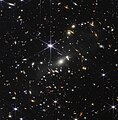Ladawan:Webb's First Deep Field.jpg

Pakadakula kan pasirip na ini: 587 × 599 na pixel. Ibang mga resolusyon: 235 × 240 na pixel | 470 × 480 na pixel | 753 × 768 na pixel | 1,003 × 1,024 na pixel | 2,007 × 2,048 na pixel | 4,537 × 4,630 na pixel.
Orihinal na file (4,537 × 4,630 na pixel, pakadakula: 16.43 MB, tipo nin MIME: image/jpeg)
Kasaysayan kan file
Pinduton an sarong petsa/oras para mahiling ng file sa puntong idto.
| Petsa/Oras | Thumbnail | Sukol | Paragamit | Komento | |
|---|---|---|---|---|---|
| presente | 12:14, 22 Setyembre 2022 |  | 4,537 × 4,630 (16.43 MB) | Habitator terrae | better quality |
| 22:54, 11 Hulyo 2022 |  | 4,537 × 4,630 (1.86 MB) | Habitator terrae | {{JPEG version of TIF}} {{Information |description={{en|1=NASA’s James Webb Space Telescope has produced the deepest and sharpest infrared image of the distant universe to date. Known as Webb’s First Deep Field, this image of galaxy cluster SMACS 0723 is overflowing with detail. Thousands of galaxies – including the faintest objects ever observed in the infrared – have appeared in Webb’s view for the first time. This slice of the vast universe is approximately the size of a grain of sand hel... |
Paggamit sa file
Mayong pahinang naggagamit sa file na ini.
Pankinaban na paggamit sa file
Ginagamit kan mga minasunod na wiki an file na ini:
- Paggamit sa ar.wikipedia.org
- بوابة:علم الفلك
- مقراب جيمس ويب الفضائي
- أعمدة الخلق
- مركز غودارد لرحلات الفضاء
- وكالة الفضاء الكندية
- ويكيبيديا:صور مختارة/الفضاء والكون/نظرة إلى الأعلى
- بوابة:علم الفلك/صورة مختارة
- بوابة:علم الفلك/قوالب
- جيمس إدوين ويب
- معهد مراصد علوم الفضاء
- قائمة الحقول العميقة
- قالب:مقراب جيمس ويب الفضائي
- بوابة:علم الكواكب غير الشمسية/قوالب
- بوابة:علم الكواكب غير الشمسية
- درع شمسي لمقراب جيمس ويب الفضائي
- كاميرا نيركام
- كاميرا ميري (للأشعة تحت الحمراء المتوسطة)
- مطياف نير
- الحقل العميق الأول لويب
- عنقود مجرات SMACS 0723
- ويكيبيديا:ترشيحات الصور المختارة/الحقل العميق الأول لويب
- ويكيبيديا:صورة اليوم المختارة/أغسطس 2022
- قالب:صورة اليوم المختارة/2022-08-15
- بوابة:علم الفلك/صورة مختارة/81
- سيرس-93316
- Paggamit sa as.wikipedia.org
- Paggamit sa av.wikipedia.org
- Paggamit sa az.wikipedia.org
- Paggamit sa be.wikipedia.org
- Paggamit sa bg.wikipedia.org
- Paggamit sa bn.wikipedia.org
- Paggamit sa ca.wikipedia.org
- Paggamit sa ckb.wikipedia.org
- Paggamit sa cs.wikipedia.org
- Paggamit sa de.wikipedia.org
Hilingon an kadagdagan na pankinaban na paggamit sa file na ini.



